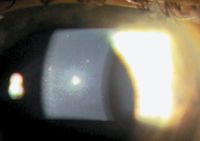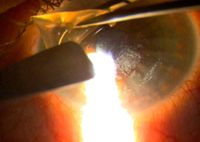Article
MRSA keratitis is rare complication after LASIK
Editor's Note: Joshua D. Stein, MD, MS, of New York University School of Medicine and Manhattan Eye, Ear, and Throat Hospital (MEETH), was named the winner of the second annual Ophthalmology Times Resident Writer's Award Program—presented during the American Academy of Ophthalmology annual meeting in New Orleans. Dr. Stein's winning submission is featured here. He was nominated by Laurence T.D. Sperber, MD, the residency program director and clinical associate professor of ophthalmology at New York University School of Medicine and director of the Cornea Service at MEETH in New York.
Editor's Note: Joshua D. Stein, MD, MS, of New York University School of Medicine and Manhattan Eye, Ear, and Throat Hospital (MEETH), was named the winner of the second annual Ophthalmology Times Resident Writer's Award Program-presented during the American Academy of Ophthalmology annual meeting in New Orleans. Dr. Stein's winning submission is featured here. He was nominated by Laurence T.D. Sperber, MD, the residency program director and clinical associate professor of ophthalmology at New York University School of Medicine and director of the Cornea Service at MEETH in New York.

Abstract A 45-year-old male patient developed pain and a foreign-body sensation in his left eye 2 days after he had underwent uneventful bilateral LASIK. The patient was found to have a corneal infiltrate unresponsive to third-generation fluoroquinolone antibiotics. Laboratory investigation of corneal scrapings revealed methicillin-resistant Staphylococcus aureus (MRSA) keratitis. The keratitis responded to vancomycin, and the patient eventually developed a central scar. After excision of the overlying necrotic flap and application of topical mitomycin-C (Mutamycin, Bristol-Myers Oncology) to the underlying stroma, the patient's vision subsequently improved to 20/30. This paper provides a review of MRSA keratitis after LASIK and discusses the risk factors and the treatment options for this unusual, yet potentially serious, condition.

History A 45-year-old nurse with a history of non-insulin-dependent diabetes mellitus was referred to the cornea clinic at Manhattan Eye, Ear, and Throat Hospital (MEETH) for evaluation of a corneal infiltrate in his left eye. He had had uneventful bilateral LASIK performed 1 week earlier to treat moderate myopia. Two days after the surgery, he presented to his ophthalmologist complaining of pain and a foreign-body sensation. At that visit, the patient received a diagnosis of corneal infiltrate and was told to continue taking ciprofloxacin 0.3% (Ciloxan, Alcon) and prednisolone acetate 1% eye drops, which had been prescribed after the surgery. Three days later, the antibiotic drops were discontinued, and the patient continued taking prednisolone. On postoperative day 7, the patient was referred to MEETH after complaining of persistent blurry vision, worsening pain, and sensitivity to light in his left eye.

Discussion and diagnosis The differential diagnosis of a patient with a corneal infiltrate that develops after LASIK includes microbial keratitis (bacterial, mycobacterial, fungal, viral), diffuse lamellar keratitis (DLK), and a sterile infiltrate. The presence of various characteristic features of the infiltrate can be useful in determining whether the cause is infectious or noninfectious, as in DLK.
Newsletter
Don’t miss out—get Ophthalmology Times updates on the latest clinical advancements and expert interviews, straight to your inbox.




